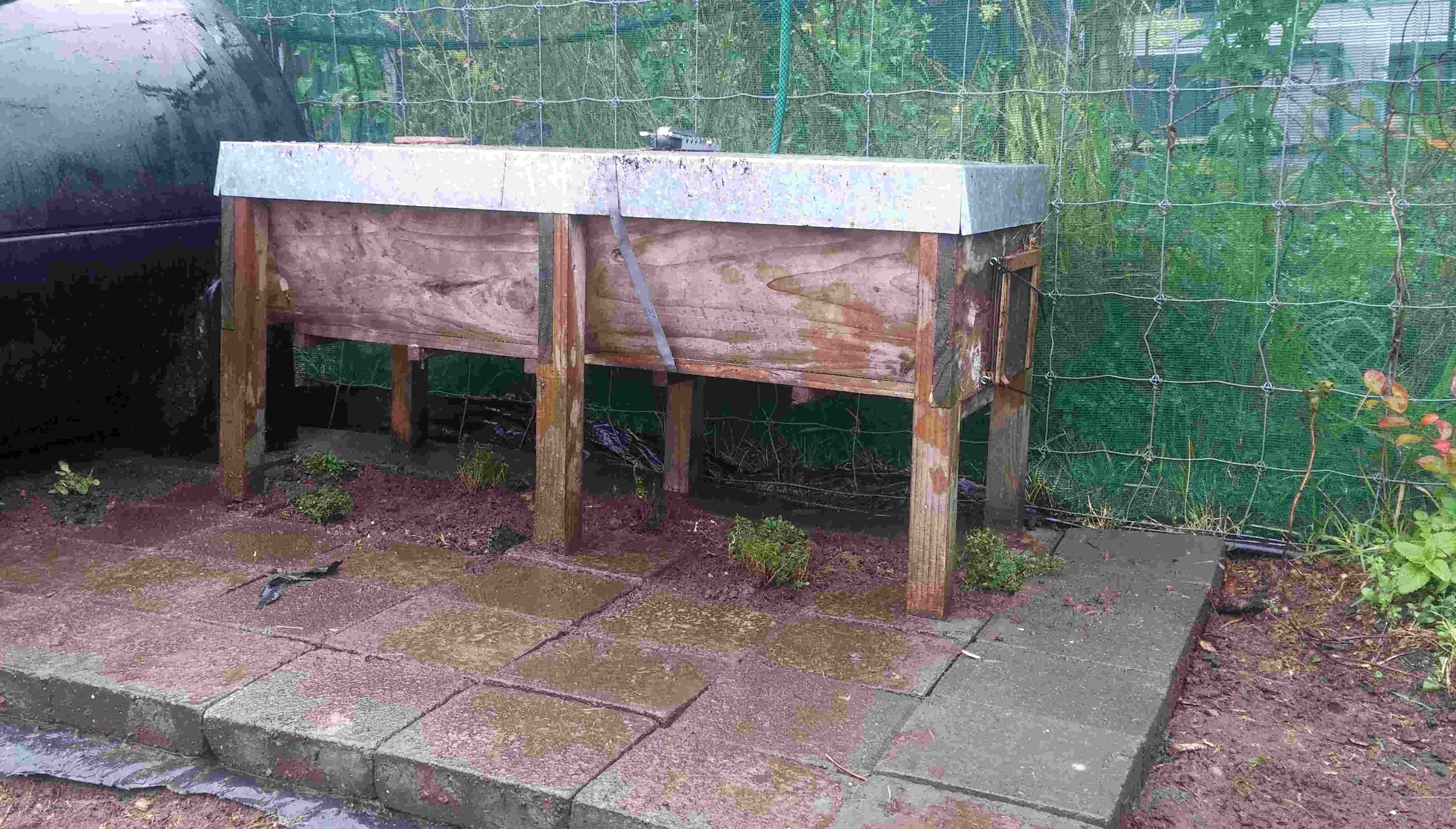VITAE ESSENTIA
The Essence of Life
Bee Garden
We all know bees are really important part of the environment. Here at Vitae Essentia’s base we are growing herbs and a food forest, therefore pollination is an essential process, hence the need for hives and also the importance of supporting these essential insects. Any honey, wax or propolis gained from the hives are great by products, if available, as long as the bees are not left short or compromised. I am happy to keep the bees happy and grateful for the pollination they do for my crops. Previously we used to rent a bee hive, I learnt a little from the apiarist who looked after the hive but things did not work out with a rental hive. The decision was made to keep our own hives, although with a little trepidation at first, learning to looking after a colony of stinging insects will do that to many folk. However the art of bee keeping, for that is what it is, has really grown on me. I love spending time with my buzzy friends and they have taught me so much. I am actually glad the rental hive didn’t work out otherwise I wouldn’t have chosen to learn beekeeping.
 I decided to join an apiary course last year and was blessed with an excellent tutor called Judy Knipmeijer, who I highly recommend if you are interested in learning about bees. The course provided us all with a wooden Langstroth (box) hive we had to construct, all we had to do was obtain bees to put into them. Luckily, a work colleague and fellow apiarist Andy Walford supplied me with my first swarm of bees, for which I was very grateful. Low and behold a hive with a colony of bees. Awesome.
I decided to join an apiary course last year and was blessed with an excellent tutor called Judy Knipmeijer, who I highly recommend if you are interested in learning about bees. The course provided us all with a wooden Langstroth (box) hive we had to construct, all we had to do was obtain bees to put into them. Luckily, a work colleague and fellow apiarist Andy Walford supplied me with my first swarm of bees, for which I was very grateful. Low and behold a hive with a colony of bees. Awesome.
Transferring the swarm from their transported hive to their new home literally left me covered in bees, I’m sure Eddie Izzard would have approved. This wee colony has grown and grown, I managed to split the hive twice throughout the year and now have 3 hives which are strong and well. My son has also taken an avid interest in bee keeping and has learnt a whole heap, which he happily shares when we are down the hives.
During the course I also spent a large amount of time working a topbar hive, these hives are very different to the more common Langstroth hives, they are a more traditional style. Topbars can be harvested for honey but are great for pollination. I had the pleasure of working with a topbar hive on my course and really enjoyed this. The topbar I worked grew from a small colony in the spring to a beautiful strong and productive hive throughout the year, hence the reason I snapped at the opportunity to buy a topbar hive. I got the hive in the latter part of the summer with a small colony. Initially it started to grow well but topbar hives are a lot more work for bees. The Langstroth hive, which is can be seen in many a paddock and garden, has frames with foundation, which is a wax base that the bees can use to start their comb. The topbar hive is completely empty other than a wood bar which the bees free comb on and has to be built from scratch. Bees have to consume approximately 8g of honey to produce 1g of wax, so you can get an idea that this takes a lot of work for our buzzy friends. Unfortunately my poor wee colony got attacked by wasps and ants, I was then at work for a period of 8 days during the wonderous times of COVID, on the first day off I had, I arrived at the hive in time to see the Queen and the remains of her colony leave. You can hardly blame them. However sad this was, I learnt an awful lot. The fact I have three hives from 1 swarm in Langstroth hives started in spring compared to a lost topbar hive started in late summer shows one factor that compromised the hive.
My hives are all based in my paddocks, so it is a bit of a mission to get myself and any equipment down there. I am slowly building a bee garden around these hives. However, the loss of the topbar gave me the opportunity to move the hive up to the house. Here it is placed by my veggie garden and stock gardens. It is behind a fence for the protection of others, when fully armed with bees but also in close proximity to the house, that way I can keep a closer eye on it. Topbar hives by their nature need more attention, bees free combing can have a tendency to build as they would in the wild, however part of keeping bees means that you need to be able to remove each frame of comb for inspection for pests and diseases such as varroa or American foul brood (AFB). You therefore have to give them more attention to keep the hive in a more human ordered fashion rather than bee ordered.
The garden I am using is on the top of a hill, I have had a garden here for a little while. I reclaimed it 2 years ago. I am gradually replanting the slope of the hill. When we moved to the property it was just bare grass, grazed by sheep – green desert, all grass and nowt else. Now the sheep have gone and nature is having her way. We have a whole bunch of trees now growing on the bank of varying sizes when full grown. Some have been planted by me, others have self planted. At the top of the bank I have grown kumara, pumpkins and corn and cucumbers. Winter is always the time when you have to really knock back the couch grass. I am very grateful this grass holds my hill together, being as though previous occupants here stripped the trees away. However, the couch grass is invasive and needs to be removed, the easiest way is to shad it out but plants have to grow tall enough to shade it out. Therefore, areas of couch grass are removed so other plants can establish. The root network of the other plants as they grow will take over holding the land together, particularly the trees, shrubs and deep rooted plants i.e. comfrey, burdock and chicory.
 I have been stripping back the garden, harvesting any seeds and then weeding plants out. Along the edges there are small blueberry bushes, I am going to plant several more along the bottom row. There is a nice sized lemon balm and some feverfew. At the end of the garden sizable patch of spearmint. I have harvested a handful of stolons to grow for the other bee garden. Spearmint is an awesome plant for bees, its essential oil is used as a treatment for varroa, a parasitic mite that can be deadly to honey bees. So I am going to encourage this wee plant to grow. I also have a sizeable patch of peppermint, also used in the treatment of varroa, again this may be helpful in supporting the bee health.
I have been stripping back the garden, harvesting any seeds and then weeding plants out. Along the edges there are small blueberry bushes, I am going to plant several more along the bottom row. There is a nice sized lemon balm and some feverfew. At the end of the garden sizable patch of spearmint. I have harvested a handful of stolons to grow for the other bee garden. Spearmint is an awesome plant for bees, its essential oil is used as a treatment for varroa, a parasitic mite that can be deadly to honey bees. So I am going to encourage this wee plant to grow. I also have a sizeable patch of peppermint, also used in the treatment of varroa, again this may be helpful in supporting the bee health.
So back to the garden, the couch grass was tamed back, compost added to the top soil to aid in soil nutrition, and the area the topbar is going to be situated has been paved. Underneath the topbar a bed of thyme plants has been added. The aim being the aroma of the thyme will constantly float into the hive. When the plant is in flower, the bees can forage of the flowers utilsing the medicinal affects of the plant. Thyme essential oil is also a treatment for varroa, it is also used in commercial bee products, an extract of the essential oil being used as the active ingredient. Other plants to be included in the garden are oregano, marjoram, lemon grass, dandelion, sage, hibiscus and strawberry.
The majority if not all the bee colonies / hives are now infected with varroa, if this is not treated, it can lead to colony collapse and the loss of a whole hive. Varroa is mainly treated with commercial agrichemicals produced by pharmaceutical companied. The products used have to be rotated in order to have the highest efficacy in removing varroa, the mites become tolerant to the treatment. I have some issue with this. Firstly, the same companies that produce the treatment for varroa are also producing the herbicides and pesticides that are linked to the death of bees and colony collapse. Secondly, Vitea Essentia is a natural health company, that is aware of how pharmaceutical products are pushed as being better than a healthy diet and lifestyle, whilst not teaching the general public on what a healthy diet really is. My intention is to keep the bees using a more natural method than relying on chemical to save the bee.
I intend to experiment with this garden and see the effects these medical plants have on bee health. Unfortunately bees that are commercially used for pollination experiencing a greater amount of stress. They are moved from one location to another and then mainly feed on one food source, the crop they are pollinating, often this is a monoculture. The lack of diversity in the food and therefore their nutritional intake would undoubtedly mean there is a decrease in the amount of macro (carbohydrates, lipids, proteins and water) and micronutrients (vitamins and minerals). Hypothetically, it seems to make sense that a lack of nutrients would exacerbate stress and therefore be detrimental to the bees health, similarly to humans. It was really interesting when studying the signs of illness in bees the correlation to some human presentation too. i.e. there is a virus that paralyses the bee, one of the signs is the bee loses its hair. The paralysis virus is also linked with low amounts of pollen, which is also a rich source of vitamin B complex. Lack of vitamin B complex in humans can also lead to hair loss. Obviously, the anatomy and physiology of a bee and human are very different but the similarities in these presentations makes one question. Therefore, the aim is to provide a rich a diverse bee friendly garden and observe the impact on the bees. I look forward to sharing my findings.





